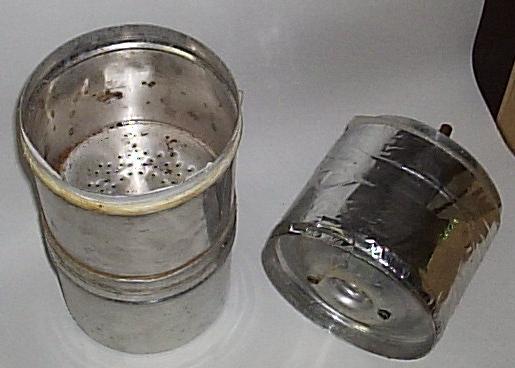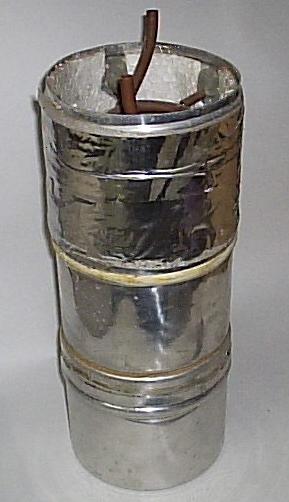I promised unionised I would describe the reflux apparatus that is commonly used in the far north of Ontario, Canada for extracting the oil
and resins of "miscellaneous" herbs. I am not certain it can be of use to a chemist, but who am I to judge?
***Legal Disclaimer***I don't do this anymore, as I am now a paraplegic, and too old for that sort of
shennanigans anyway.
The apparatus described was made to solve a local problem; in Thunder Bay Ontario and parts north, locals grow alot of a certain plant, in fact they
grow very large fields of it, partly because it's a basically uninhabited wilderness, partly just for kicks.
However, the seed stock that is used to grow this particular herb is crappy (genetically speaking) so they grow large feilds of it, making up for
quality with quantity. It would probably be wiser to just invest in some good seeds from amsterdam or something, but you really have to understand the
mentality of the locals to understand.
Anyway;
Having vast quantities of a pretty crappy product on hand, and having a history of moonshining they turned their hands to reducing this bulk into a
more usable and compact product. This is a description of the resulting apparatus.
It consisted of two steel drums, one sitting vertically on top of the other, the top drum was the condenser, it was sealed except for and inlet and
outlet spigot. It also had bars of steel 1/2 inch thick ( normally used for re-inforcing concrete) running vertically through small holes in the top
and bottom ends of the drum, these holes were welded shut around the bars after placement so they would be water tight. the bars would be cut almost
flush with the top exept for two nubs left long and joined by a welded horizontal bar to function as a handle for lifting (with the rebar in it, it
was damn heavy!)
the bottom ends of the rebar were left about five inches long and the center one had a small steel hook welded to it to hold the "basket
bucket".
That was the top metal drum condenser.
The bottom drum had the top metal almost completely cut out, leaving only about a two inch strip of sheet metal around the circumference for strength.
three small guides were welded vertically to the top of the bottom drum so that when the top (condenser) drum was place on top of the bottom drum,
they stayed mated together nicely. they were usually cut out of common 1/8 inch x 2 inch steel strap or angle iron or whatever was handy.
The bottom drum then had a round pan cut from the base of a metal five gallon pail placed into the bottom of it, the round bottom pan had sides about
a foot high and a wire handle for lifting it out. It received the "oils and essences"
The top edge of the bottom barrel had the rubber from an old inner tube placed on it for a gasket, the weight of the top barrel filled with water was
sufficient to keep the seal good enough.
A small hole is placed in the bottom barrel and fitted with a nipple that accepts a thin peice of copper tubing (for pressure relief).
a clean five gallon metal pail had holes punched in the center 2/3 of the bottom for drainage and wire (screen door) mesh placed in the bottom of it.
THERE!.... it might seem tedious but can be welded up in an easy afternoon once you've done it a couple times.
So, the bottom drum goes on top of a fire grate, with your firewood stacked and packed under it (unlit!!!). the receiver pan is placed in the bottom
of the bottom barrel and mostly filled with solvent of choice (don't worry if a little slops out into the bottom just make certain it's not
overfilled) , the five gallon "Basket bucket" is filled with dry powdered "miscellaneous" herbal product, that was soaked with
solvent, and the wire handle is placed onto the hook of the condenser barrel.
The condensor (upper) barrel is placed on the top of the bottom barrel with the gasket in place.
The upper barrel is filled with icy-cold water.
The fire is lit.
the solvent boils up, the fumes hit the rebar nubs, the rebar nubs condense the fumes and the solvent drips onto the top of the solvent soaker herb
and a little solvent drips out the bottom.
It drips into the receiver pan, that will still have boiling solvent in it.
The boiling solvent boils out more solvent fumes but leaves the oils behind.
the fumes rise, condense, percolate through, drip into the bottom, drops off its little load of the oil,
solvent boils off......fumes rise....condense....percolate....
drip..... ...drip..... ..drip....
A virtual herb washing machine.
After a half-day or so, the now completely empty herb bucket is removed and replaced with another, and another, until the receiver pan needs to be
emptied of oil.
Then, the "basket bucket" is replaced with and empty pail without holes. The solvent boils out of the oil on GENTLE heating and condenses
and collects into the top pail for re-use.
the oil is scraped out of the reciever pan while still warm.
The solvent soaked "empty" herbal product can be put into the bottom barrel to be extracted of the solvent......but it is more commonly
thrown onto a fire where it burns hot and fast and down to a fine white ash.
Well, I'm beginning to wish I knew how to use a program that allowed me to just draw a fricking picture, maybe if one of my cousins feels like
dragging my crippled ass out into the bush this summer, I'll be able to take some digital pictures, but I'm not certain about that.
-----------------------------------------------------
Harvest season is pretty hectic around here, all the local cops call in their buddies and chase the locals around in the bush. It's like a
goodnatured adult version of hide and seek.
But it's damn hard to run through the bush in a wheelchair.
And it would probably be hard to come up with an even slightly plausible explanation for me, sitting in a field of dope, in a wheelchair, nine klicks
from the nearest logging road.
and I can't afford the fine I'd get for possesion of that kind of quantity.
(unlike the states, possesion of pot here generally results in a fine, even repeat offences, while having a handgun will get you a solid five years in
prison, the very first time.)
 amount of exports to the pacific rim countries (notably Japan and
Taiwan)
amount of exports to the pacific rim countries (notably Japan and
Taiwan)



